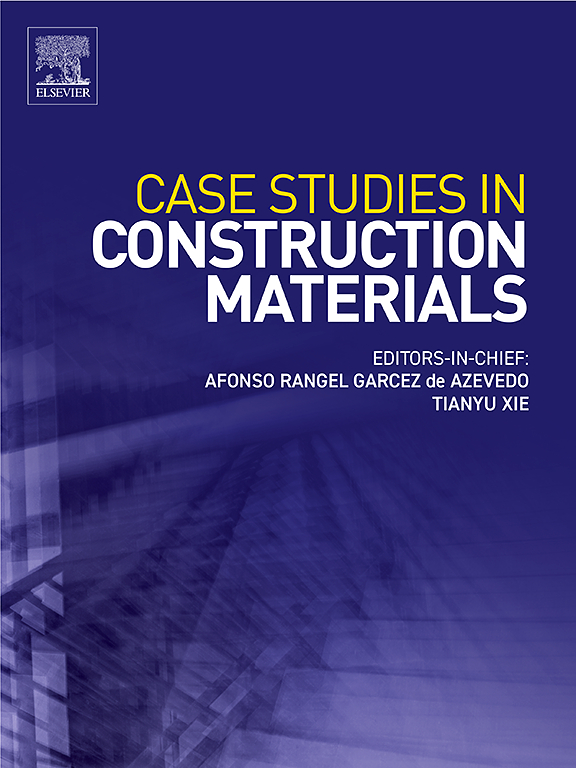冻融循环对矿渣-粉煤灰基地聚合物胶结铁尾砂弯曲性能和微观结构的影响
IF 6.6
2区 工程技术
Q1 CONSTRUCTION & BUILDING TECHNOLOGY
引用次数: 0
摘要
本研究旨在揭示渣粉煤灰胶结铁尾矿控砂低强度材料(SFG-T-CLSM)在冻融循环作用下的损伤特性,以及纤维增强SFG-T-CLSM耐久性的机理。通过三点弯曲试验、CT扫描试验和扫描电镜(SEM)试验,综合分析纤维增强SFG-T-CLSM在冻融环境下的微观结构变化和宏观力学性能响应。研究结果表明:随着冻融循环次数的增加,SFG-T-CLSM的抗弯强度逐渐降低。经15次冻融循环后,未添加纤维的试件抗弯强度损失为43.84 %,而添加5 ‰纤维后,强度损失降至29.10 %。三维重建CT切片显示基质内孔隙数量逐渐增加。而在冻融循环过程中纤维的存在有效地缓解了孔隙发育,起到了桥接裂缝和分散应力的作用,改善了CLSM基体内部的孔隙分布特征,显著减少了裂缝的数量和宽度,显著提高了SFG-T-CLSM的抗裂能力。SEM结果进一步证实了纤维在恶劣冻融循环环境下通过其三维网络结构表现出显著的抗损伤作用。随着冻融循环次数的增加,纤维的脱粘模式逐渐演变:从早期粘结良好,到中期界面损伤,再到后期明显脱粘。因此,纤维在SFG-T-CLSM中的作用逐渐减弱,其抗裂性和结构完整性也随之下降。本研究表明,纤维的引入是提高CLSM冻融耐久性的有效策略,为提高CLSM在极端环境下的应用提供了理论依据。本文章由计算机程序翻译,如有差异,请以英文原文为准。
Effect of freeze-thaw cycles on bending properties and microstructure of slag-fly ash based geopolymer cemented iron tailings sand
This study aims to reveal the damage characteristics of slag-fly ash cemented iron tailings sand controlled low-strength material (SFG-T-CLSM) under freeze-thaw cycles, as well as the mechanism of fibers enhancing the durability performance in SFG-T-CLSM. Through three-point bending tests, CT scanning tests, and scanning electron microscopy (SEM) tests, the microstructural changes and macro-mechanical property responses of fiber-reinforced SFG-T-CLSM in freeze-thaw environments were comprehensively analyzed. The research results show that: with the increase in the number of freeze-thaw cycles, the flexural strength of SFG-T-CLSM gradually decreases. After 15 freeze-thaw cycles, the flexural strength loss of the specimen without fiber addition is 43.84 %, while the strength loss decreases to 29.10 % after adding 5 ‰ fibers. Three-dimensional reconstructed CT slices reveal that the number of pores inside the matrix gradually increases. However, the presence of fibers during freeze-thaw cycles effectively alleviates pore development, plays a role in bridging cracks and dispersing stress, improves the pore distribution characteristics inside the CLSM matrix, significantly reduces the number and width of cracks, and remarkably enhances the crack resistance of SFG-T-CLSM. SEM results further confirm that fibers exhibit significant anti-damage effects in SFG-T-CLSM under harsh freeze-thaw cycle environments through their three-dimensional network structure. The debonding mode of fibers gradually evolves with the increase in the number of freeze-thaw cycles: from good bonding in the early stage, to interfacial damage in the middle stage, and then to significant debonding in the later stage. Consequently, the role of fibers in SFG-T-CLSM gradually weakens, and the crack resistance and structural integrity also decline accordingly. This study demonstrates that the introduction of fibers is an effective strategy to enhance the freeze-thaw durability of CLSM, providing a theoretical basis for improving the application of CLSM in extreme environments.
求助全文
通过发布文献求助,成功后即可免费获取论文全文。
去求助
来源期刊

Case Studies in Construction Materials
Multiple-
CiteScore
7.60
自引率
19.40%
发文量
842
审稿时长
63 days
期刊介绍:
Case Studies in Construction Materials provides a forum for the rapid publication of short, structured Case Studies on construction materials. In addition, the journal also publishes related Short Communications, Full length research article and Comprehensive review papers (by invitation).
The journal will provide an essential compendium of case studies for practicing engineers, designers, researchers and other practitioners who are interested in all aspects construction materials. The journal will publish new and novel case studies, but will also provide a forum for the publication of high quality descriptions of classic construction material problems and solutions.
 求助内容:
求助内容: 应助结果提醒方式:
应助结果提醒方式:


